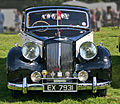Austin Sheerline
| Austin Sheerline A110 and A125 | |
|---|---|
 A125 | |
| Overview | |
| Manufacturer | Austin |
| Production | 1947–1954 |
| Body and chassis | |
| Body style | 4-door saloon 4-door limousine (lwb) Ambulance (lwb) Hearse (lwb) |
| Related | Austin Princess |
| Powertrain | |
| Engine | A110: Austin D-Series 3,460 cc (211.1 cu in) A125: Austin D-Series 3,995 cc (243.8 cu in) 6-cylinder overhead-valve |
| Dimensions | |
| Wheelbase | 3,028.9 mm (119.25 in) 3,352.8 mm (132 in) (lwb) |
| Length | 4,864.1 mm (191.5 in) |
| Width | 1,854.2 mm (73 in) |
| Height | 1,701.8 mm (67 in) |
| Kerb weight | 1,880–2,032 kg (4,145–4,480 lb) |
| Chronology | |
| Predecessor | Austin 28 Ranelagh 4016cc (announced August 1938) |
| Successor | Austin A135 Princess Vanden Plas Princess |
The Austin Sheerline is a large luxury car produced by Austin in the United Kingdom from 1947 to 1954.
The Sheerline was designed by Austin during the Second World War, but volume production did not begin until 1947 because of the commitment to war production. It was a luxurious car in the style of the contemporary Rolls-Royce or Bentley but at a much lower price, around two-thirds that of the equivalent Rolls-Royce but still the price of five or six small Austins. There were about 8,000 built.
The first cars,[1] designated A110, had a 3,460 cc straight-six overhead valve engine but this was soon[2] increased to 3,995 cc with 125 bhp (93 kW) and the designation then became A125. Initially only a Saloon version on a 9-foot-11¼-inch (3 metres) wheelbase chassis was made, but this was joined by a Limousine version in late 1949[3] on a stretched 11 ft (3.3 metres) chassis also used for a hearse and an ambulance. At 37 hundredweight (1,850 kg) for the saloon and 2 tons (2,000 kg) for the limousine this was a heavy car, and to maintain performance a low final drive ratio of 4.55:1 with 16-inch tyres was fitted. Suspension was by coil springs at the front and half-elliptic leaf springs at the rear. The saloon version had a top speed of 82 mph (132 km/h).
Production ceased in 1954 and Austin's luxury offering was limited to the A135 Austin Princess.
The general consensus is that in the Last Of The Summer Wine episode The Loxley Lozenge, the chassis of an Austin Sheerline was used as a prop for the titular fictional vehicle. [4]

Austin A125 Sheerline

Austin A125 Sheerline

Long wheelbase limousine

1949 Saloon pictured at Knebworth in 2016
The early wartime cars were fitted with the smaller 2912cc engine.
References[]
- ^ New Austin Cars
The first new British cars to be introduced since the war by one of the large manufacturers have now been announced. They are the Austin Sheerline 110 and Princess 120 saloons, the former with knife-edge coachwork made at Longbridge Birmingham and the latter having a more streamlined body which is the work of Vanden Plas, the coach building firm acquired by Austins last year. The chassis of both cars is similar, the only difference being in the number of carburettors. The figures after the names of the models indicate the brake horse-power. The cars are new from end to end, and the specifications include a new three and a half litre six-cylinder, overhead valve engine, steering column control of the four-speed synchromesh gearbox, independent front suspension using coil springs, and hydraulic brakes. The prices are £1,278 for the 110 and £1,917 for the 120, including purchase tax.
"New Austin Cars". The Times. No. 50709. 14 March 1947. p. 6. - ^ Austin Lorries Dearer
Increased prices for all Austin commercial vehicles come into force today. . . . The change in engine size of the big Austin car from 3½-litres to 4-litres has been accompanied by alterations in the designation, and the two models on this chassis will be called in future the A125 Sheerline and the A135 Princess. The figures denote the brake horse-power.
"News In Brief". The Times. No. 50916. 12 November 1947. p. 2. - ^ "Austin". The Times. No. 51500. 30 September 1949. p. 3.
- ^ DigitalCavalry (17 July 2015). "Christmas Special 1984: The Loxley Lozenge". Summer Winos. Retrieved 29 July 2020.
Further reading[]
- Robson, Graham (1987). The Cars of BMC. Motor Racing Publications. ISBN 0-947981-14-4.
External links[]
| Wikimedia Commons has media related to Austin A125. |
- Austin vehicles
- Cars introduced in 1947
- Limousines




